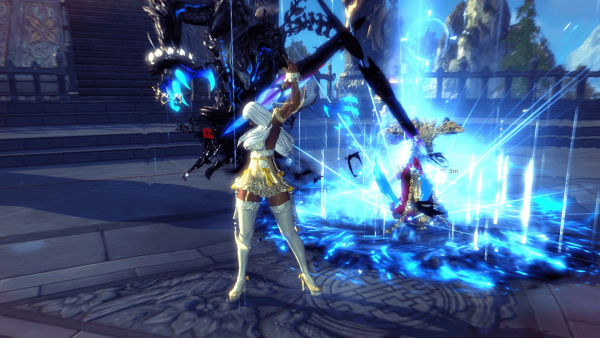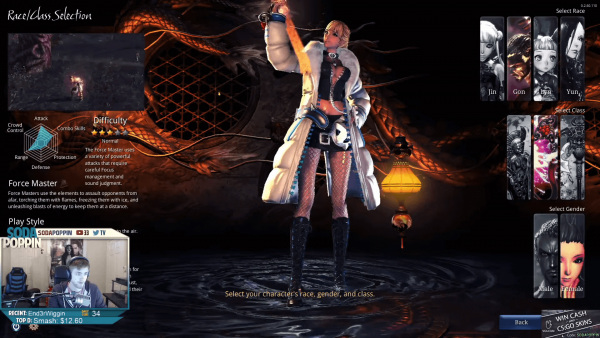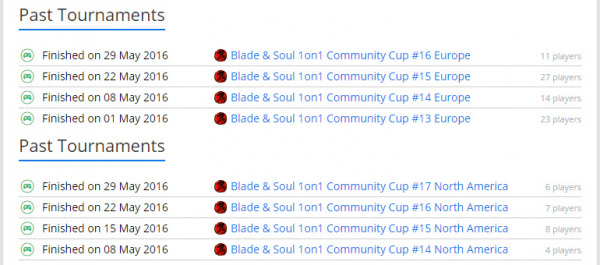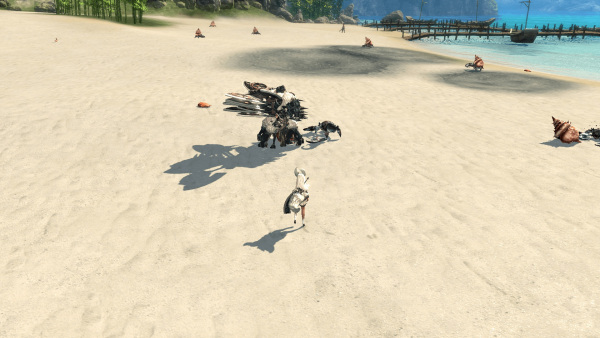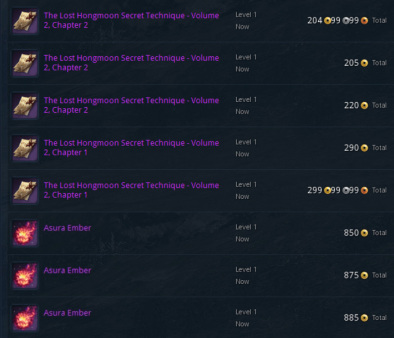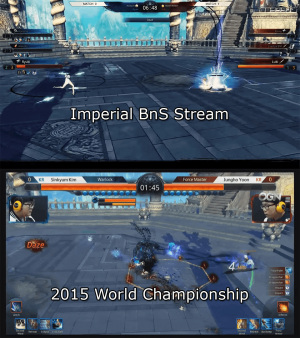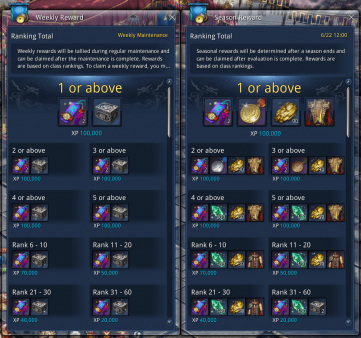Blade And Soul's Fading eSports Dream

In 2009, NCSOFT premiered their first Blade and Soul trailer at G-Star, a gaming convention in South Korea. The trailer showcased impressive visuals, flashy combat, and a wuxia inspired setting. In June 2012, Blade and Soul officially launched in Korea and at Gamescom. That same year NCSOFT announced plans to bring Blade and Soul to the West.
Western fans got a glimpse of Blade and Soul’s competitive scene in South Korea thanks to FreedomPlays, a community that specializes in foreign MMOs, uploading two videos showing off the 2013 Blade and Soul PvP Tournament. Despite the long wait time hype was building up. Eager fans resorted to playing other versions of the game, longing for the day NCSOFT would bring Blade and Soul to Western shores and with it the prospect of a new MMO eSport.
Fancy poses and skill effects are abundant in Blade and Soul’s combat
Meanwhile in the West World of Warcraft was making waves as the MMO to play with a promising eSports scene. By the time Blade and Soul’s first trailer was revealed World of Warcraft was approaching its third year of competitive events, several of which were hosted by big name eSports organisations such as Major League Gaming and Intel Extreme Masters. Unfortunately, World of Warcraft began to decline as an eSport between 2010 and 2011. Major League Gaming had problems finishing their 2010 World of Warcraft season due to the release of the Cataclysm expansion, and Intel Extreme Masters dropped World of Warcraft from their 2011 lineup.
In 2015, Blade and Soul was finally announced for the West and given an official release date of January 19th 2016. The wait for a fresh new MMO eSport was over.
A Falling Star
During its alpha and beta tests in late 2015, Blade and Soul exploded onto Twitch and attracted a huge amount of attention. Big name streamers like Sodapoppin and World of Warcraft arena veterans such as Reckful, Bajheera and Vanguards all had positive comments about the game. Jaesung Lee, the Blade and Soul 2014 World Champion, participated in several events and streams with NCWest to promote the game and created YouTube content to help players.
Twitch.tv streamer Sodapoppin showing his viewers the various classes in Blade and Soul.
The good news didn’t stop there.
During Blade and Soul's beta test in November 2015 the rising eSports organisation Imperial took the initiative to kick start the competitive community. Imperial's founder, Averest, proposed the idea of weekly tournaments to players on Reddit. The suggestion was met with an overwhelmingly positive response and within the next few days, Imperial's first NA Blade and Soul tournament was underway.
In the same month, NCSOFT’s head of eSports development Yongjun Choi announced that the West would be able to take part in the Blade and Soul 2016 World Championship, even hinting that discussions were underway to bring Blade and Soul to existing competitive events such as EVO, the most prestigious fighting game tournament in the world.
Imperial's weekly tournaments were in full swing shortly after Blade and Soul's launch and expanded their events to cover EU players as well. Following Imperial's success, Electronic Sports League (ESL) joined the growing competitive scene and announced that Blade and Soul would become a permanent game on their eSports platform. Within a few days, the first ESL Blade and Soul community cup had over 1000 sign ups across both NA and EU. More events sprung up following the success of the first ESL cup, hosted by smaller eSports organisations like Random CS and eSports Wall. Things were looking good for Blade and Soul eSports.
Sadly, it didn’t last long.
A far cry from ESL’s 1000 sign ups in their first community cup.
On May 9th, Imperial announced they would be discontinuing their weekly Blade and Soul tournaments, citing a lack of official support for the competitive community. An official statement was released the following day describing the problems in more detail. Interest rapidly declined among competitors and tournament sign ups for other events were greatly reduced.
Though unfortunate this news came as no surprise to tournament participants and veterans of the game. Despite how bright the future once looked Blade and Soul’s Western release was hindered by many issues that would prevent it from attaining the eSports status it held in Korea.
The Barrier To Entry
Being an MMO Blade and Soul requires the player to invest some time into the game before being able to compete in the arena. Fortunately, stats are normalized in arena, making gear a non-factor and allowing non max level players to start PvPing early on. Unfortunately, a low level player will still be at a massive disadvantage against a high level opponent. Low level characters do not gain all their skills upon entering the arena, nor do they gain additional skill points to allocate into their skills to make up for the level difference.
Reaching the Level 50 cap doesn’t take too long. A seasoned player can do this in less than 24 hours and a casual player could expect to reach this within a week or two of moderate play. Sadly, the grind doesn’t end there.
Beating a higher level opponent can prove very difficult, even with the stat normalization.
Hongmoon Skills and Levels are additional advantages a player can obtain for their characters. Hongmoon Levels grant extra skill points to use, but require far more experience than regular levels. Arena balance is based on the current cap of Level 50+HM15, making it the goal for dedicated PvP players. However, reaching HM15 will take the average player a year or more of continuous play, making it an extremely time consuming hurdle to overcome.
Hongmoon Skills are upgraded versions of existing abilities that add extra control, defensive options, or in some cases, raw damage. Originally designed in the lore as legendary skills these abilities usually cost large amounts of gold or require hefty time investments to obtain. Hongmoon Skills can drastically affect arena match-ups, making it a mandatory addition for PvP players.
The Hongmoon variant of a Blade Master’s Lightning Draw skill deals almost twice the amount of damage, but at the cost of a longer cooldown
eSports thrive off large player bases and communities but for the game to grow it must be accessible and enticing for a new player. Games like Dota 2 and CS:GO require no grinding at all; once you download or buy the game you are at an equal footing with other players. Their only advantage is in skill and experience, not stats or characters. Blade and Soul could benefit greatly by lowering its entry barrier not only for new players but for returning players and existing players that want to try learn about other classes.
Bots and Cheaters
As with almost every MMO bots are ever present in Blade and Soul. They flooded the arena for the purpose of farming Soulstones, a much needed upgrade material for PvE. At times it was common to face bots more than actual players during an evening of play, making arena a tedious experience. One player on Reddit even reported not seeing a single real player within an hour of arena at the highest rating. Fortunately, the army of bots were removed and players could once again face real opponents.
Macro usage is a much loathed practice in Blade and Soul's arena. Certain classes in Blade and Soul demand dexterity and timing to pull off damaging combos, such as the Kung Fu Master’s infamous “3RF” combo. The goal of every aspiring Kung Fu Master is to master this combo and be able to pull it off consistently in high-pressure situations. Unfortunately, some players have broken the spirit of the learning process, opting to use macro software to automate the timing-intensive combo to beat their opponents. NCWest have explicitly said that macro software is a bannable offense, but detecting it can lead to false positives due to the built-in macro software on various gaming keyboards and mice.
Bots were abundant in not just arena, but in the open world as well.
Hackers are far more malicious. They can blink in and out of existence while dealing damage and teleporting across the arena, making it almost impossible to beat them. Using characters as low as Level 20 they shamelessly abused the arena system, overtaking legitimate players in the rankings and cheating them out of their end of season rewards. Blatant hackers were eventually removed but if such powerful cheats were available there is no telling what the next wave of hackers would be capable of if left unchecked.
A recent producer letter reassured players that NCWest would continue to remove these disruptive players and improve their cheat detection. Sadly, they ran rampant for far too long and have pushed many players to leave the game already.
Rapid Content Release and Balance Shifts
Because of NCSOFT’s commitment to bring western players into the 2016 World Championship patch releases are frequent to catch up to the Korean version. Months worth of content are squeezed into a few weeks for the Western version and with it, the release of new class skills that can drastically affect PvP balance.
Early during Blade and Soul’s release the Summoner class was often complained about in PvP. Summoners had the majority of their skills from an early level and many players could not deal with the onslaught of control and damage it had. They dominated the arena ladder and left many players with a sour impression of the game’s balancing. Over the next few content patches every class gained Hongmoon Levels and Skills that greatly affected the summoner match-up. The arena ladder is now much more varied with every class present in the top 10 on EU as of writing.
Summoners no longer dominate the arena ladders with the addition of Hongmoon Levels and Skills.
The Assassin vs Kung Fu Master match-up is currently one of the most one-sided fights in the Western version. The Assassin class has a 50% chance to evade attacks while in stealth and many players have adopted a play style that involves staying hidden for as long as possible, making it extremely frustrating for players to deal with. Kung Fu Masters don't have many tools to deal with hidden opponents but in a future content update they will receive a new Hongmoon Skill that allows them to pull the Assassin from stealth and force a fight. It will give Kung Fu Masters a better chance of beating Assassin opponents but until the content update is released, they will have to deal with this difficult match-up.
NCSOFT have opted to let Western players experience most of Blade and Soul’s content since its initial release, but the rapid release schedule puts the game’s balance in a state of flux and players in a constant race to catch up to their peers, a race that many have already given up on. Although the balance shifts will slow down once the west has caught up to the Korean updates, it might be too late if the competitive player base has moved on to greener pastures.
Merging PvP and PvE Content
Progression in Blade and Soul relies on PvE and PvP players cooperating. Certain PvE upgrade materials are gained through PvP related activities and some Hongmoon Skill books that PvP players need are obtainable from dungeons. This seems like an interesting idea on the surface because it encourages players to combine both PvP and PvE.
Unfortunately, this doesn’t work as originally intended because of the previous point: rapid content releases. With more time between patches the supply of these items will increase and eventually become affordable for everyone. Currently, they are far too expensive for the average player to afford if they do not mix PvP and PvE. Due to the stat normalization in arena it’s unlikely a PvP-exclusive player has taken the time to upgrade their gear, making it harder for them to find dungeon groups due to their outdated equipment.
Items required for Hongmoon Skills cost hundreds of gold.
Hongmoon Levels are a mandatory PvP time sink that is made easier with PvE content. Although arena wins grant experience it’s dwarfed by the speed and ease of daily quests. A single daily quest awards more experience than multiple arena wins. They are also guaranteed experience as opposed to a potential loss which gives negligible amounts. A PvP player looking to maximize their experience gain will certainly have to complete daily quests and dungeons alongside arena.
With recent patches, players now have the option to obtain Hongmoon Skills via the arena currency, Zen Beans. Although a step in the right direction this change might have come too late since many players have already invested the time to obtain their Hongmoon Skills or worse, quit because of the PvE requirement. The Zen Bean cost is also extremely high, making it more efficient in the long run to invest time into PvE rather than farming the arena currency.
Hongmoon Levels require insane amounts of experience compared to the subscription-based Korean version (courtesy of Praetor19).
It’s understandable that NCSOFT wants to keep the game’s original design intact. Afterall, encouraging players to mix both PvE and PvP is a great idea and could get players to try out content they normally wouldn’t. Unfortunately, when it’s coupled with rapid content updates, there’s not much time for a player to indulge in both PvE and PvP while staying up to date with their gear, skills, and knowledge of other classes in arena.
No Spectator Support
One of the most important components for growing an eSport is making sure your audience can actually view the game. Sadly, Blade and Soul doesn’t have proper spectator support, making it awkward and time consuming for tournament organizers to broadcast matches to viewers. Organizers must initiate a 3v3 sparring match with the help of several volunteers to fill the extra spots. Once in the match, players quickly defeat each other until the two participants are the only ones remaining. Additional wait time is added to compensate for any skill cooldowns, and then the match can finally begin.
The official spectator client used at Korean events is far more advanced and friendly to viewers.
This entire setup process requires multiple volunteers, takes several minutes to setup, and a 3v3 match ends after a single bout. A standard arena match in Blade and Soul is a best-of-3 format, so this process must be repeated up to three times to complete a single match that would otherwise take around 5 minutes or less.
Luckily, NCWest’s recent producer letter addressed this issue, acknowledging that a functional spectator client is crucial to the success of community run tournaments. With any luck, tournament organizers will have access to a spectator client similar to the one used at official Korean events that show a wealth of helpful information.
Technical Issues
Blade and Soul’s PvP demands split second decision making and well-timed skills to pull off high damage combos. A low ping connection is essential to competitive play. Sadly, latency issues have plagued the game since its release, frustrating many players to the point of quitting. Latency spikes can ruin game winning combos, disconnects can give unfair losses, and desync issues can make players question if their opponent is hacking.
South Korea is a relatively small country with world leading internet connectivity. Gamers there are equipped with ultra-low latency connections, rendering them mostly immune to lag problems. It’s unfortunate, but the game has been designed with these stable, low-latency connections in mind, meaning Western players might experience network related anomalies while playing.
However, this doesn’t excuse the myriad of connectivity issues encountered by Western players. Some might experience lag in arena but feel no delay in the open world or vice versa. Some are forced to use VPN services to bypass routing issues in hopes of getting a stable connection to the game servers while others can play with absolutely no latency problems at all.
Connection issues can happen at the most frustrating times.
Competitive play cannot happen under unstable conditions. Match outcomes should be decided by the players not an abrupt connection issue that is out of their hands. Players in the US and EU are more spread out than those in South Korea, making solid connections an absolute must to retain player interest and competitive drive. Changing the game to compensate for higher latency is unreasonable but fixing unstable servers and routing issues should be a priority.
Growing the Community
Games require a steady inward flow of players to become a successful eSport. Blade and Soul’s release was so successful that multiple servers were added after launch to accommodate the growing player base, but the majority of players focused on PvE, not competitive PvP. Thanks to Blade and Soul’s design encouraging PvE players to try PvP isn’t very hard, but keeping them interested is difficult.
Blade and Soul PvP can be overwhelming at first—combat has a unique flow to it that takes time to adjust to, and skill build possibilities can be daunting to newcomers. Thankfully, many experienced players have created guides to help ease players into their classes. Unfortunately, they are often difficult to find or seldom kept up to date. For example, searching “kung fu master blade and soul pvp guide” in Google returns plenty of results showing combos and skill builds, but not much information on how to apply them to matches.
The amount of skills and build possibilities can be overwhelming for someone new to PvP.
The Blade and Soul community could benefit from a website or forum that focuses on PvP, a place to meet and spar new players, discuss strategy, and learn from veterans. It could serve as a hub for PvP enthusiasts to visit as a source of news, updates, and similar PvP related content such as a streamer directory. Right now there is nothing similar, and newcomers have nowhere to go besides the official forums or Reddit to look for help with their class.
Maintaining Interest
For the dedicated players that manage to look past the issues and work hard to climb the arena ladder there isn’t much motivation to continue playing.
Queue times for high-rated players can be lengthy, forcing players to create alt characters of the same class, lose on purpose to lower their ranking and find more matches, or play a friend’s character. Competition on the ladder can also feel stale compared to community run tournaments where skilled players congregate. Sadly, with Imperial dropping Blade and Soul and other tournaments receiving fewer sign ups each week, there aren’t many events left to attend.
Rewards for placing well in each PvP season are also extremely lackluster. The minimum rank to receive a reward is 300th in class rankings. While top ranks are given hundreds of gold worth of items and exclusive costumes lower ranks receive small amounts of experience and gold that could have been obtained in a single day of play. There are also weekly rewards but these are limited to experience charms that, again, could be obtained in just a single day, or items worth a little amount of gold.
The lackluster rewards given to top-ranking players at weekly and seasonal intervals.
Awarding players for their achievements is a great idea but handing out rewards to such a small portion of players can feel demotivating to those starting out and trying to improve. Expanding the reward system to include lower rank players can be a boost to their confidence and motivation, and more exclusive rewards such as titles and different costumes could give competitive players the bragging rights they deserve.
Untapped Potential
As an MMO Blade and Soul is far from dead, but as an eSport it’s most definitely fading away. The fast, skill-based combat is a wonderful, fresh experience from the usual tab-target MMOs that have dominated the market for a long time. It fits well in a competitive environment, and the variety of classes keeps it interesting to both play and watch. Where it ultimately fails is not the gameplay itself but rather how the publisher, developer, and in some part the community fail to properly support the game.
Blade and Soul’s combat is unique in the MMO genre.
Had Blade and Soul been released earlier there would be no rush to catch up to the Korean version, giving the game and community more time to develop in the West without new content updates shifting balance every few weeks. Unfortunately, the rush is already underway and both NCWest and NCSOFT need to support this rapid release of content by helping ease players into the game rather than forcing them to play for ludicrous amounts of time just to stay competitive.
Fortunately, not all hope is lost. NCWest have acknowledged they need to better support the PvP community, and Imperial founder Averest recently announced they will most likely be organizing Blade and Soul tournaments once again. The Blade and Soul 2016 Tag Championship is also being broadcast for the West on Twitch.tv, complete with English casters, a sign that NCSOFT knows there is a passionate competitive community for their game in the West.
Imperial’s return to Blade and Soul could revive a stale, dying community.
With enough support, Blade and Soul could become a popular western eSport in the future. Action is already being taken to revive the competitive scene, and hopefully it isn’t too late. I personally look forward to watching the 2016 World Championship and will be cheering for the western hopefuls that attend. With any luck, Blade and Soul’s eSports dream won’t stay a dream, but become reality.
